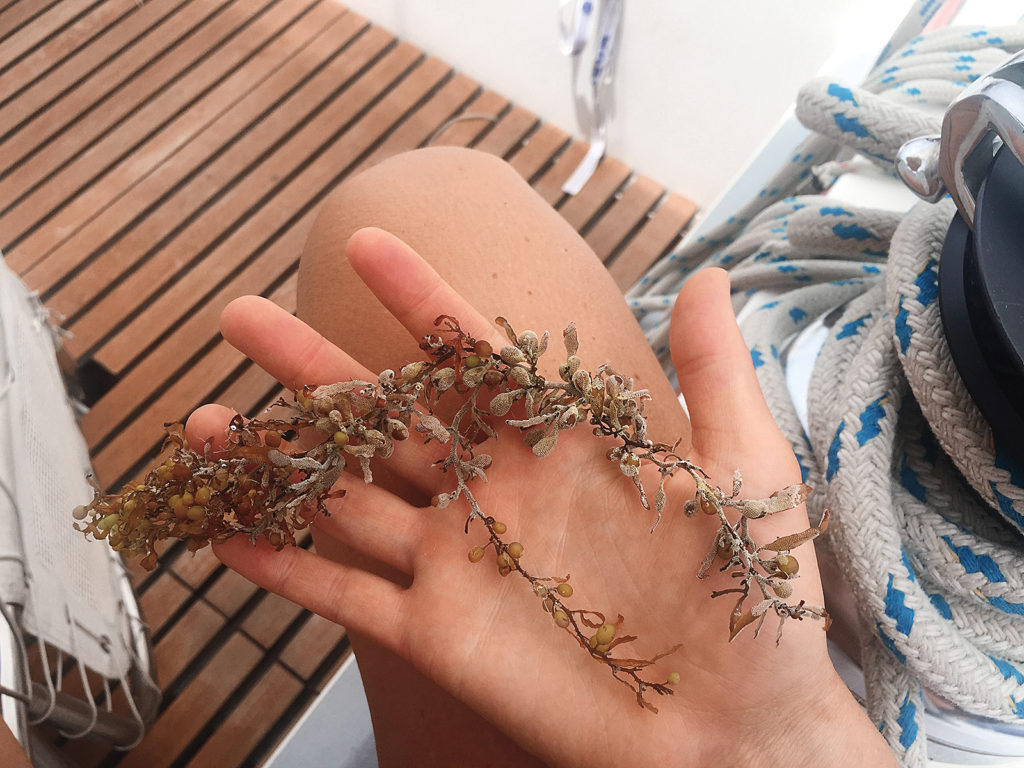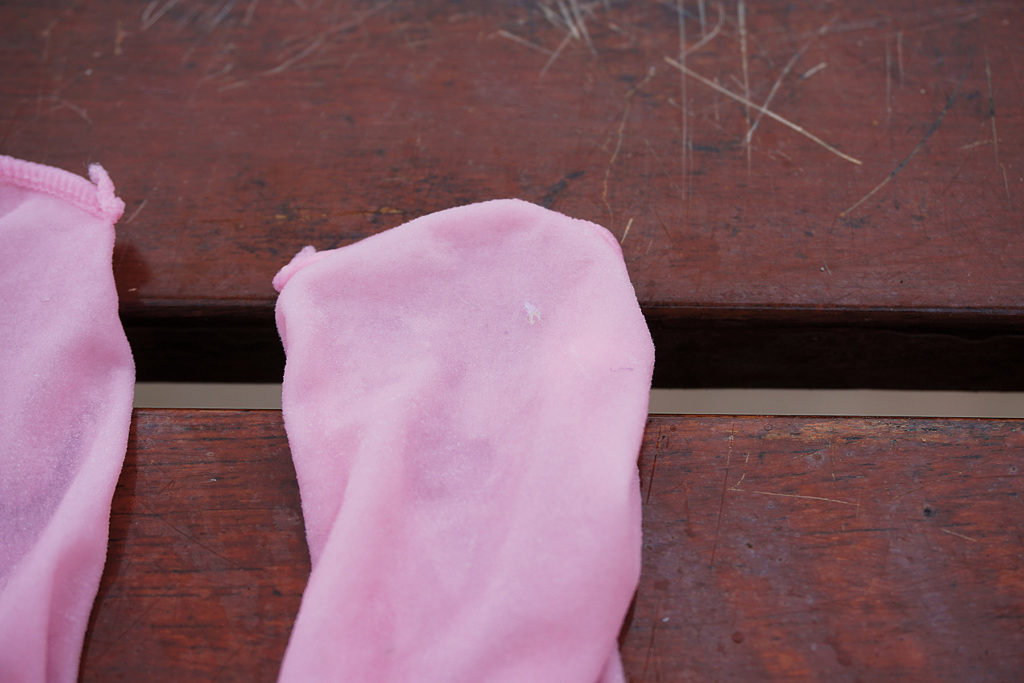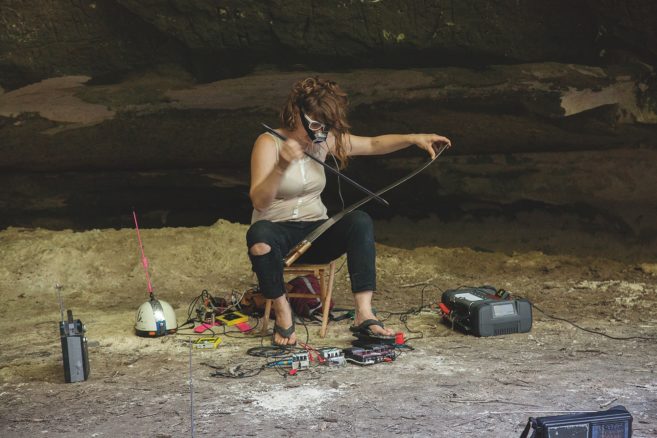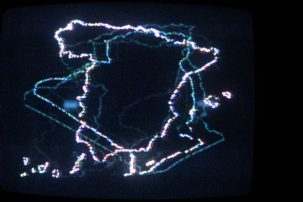IN THE GULF STREAM, somewhere between Florida and the Bahamas, I’m on watch with three men. We sail so close to a cargo ship that its wake becomes our waves. I sit on the bow and greet it. Our captain is probably asleep. It’s 100 degrees Farhenheit on deck, I’m barefoot, I’ve been sleeping in spurts for at least four days. That’s 12 watches; I count in watches now. I live by the clock on my wrist and the direction of the sails, the heading on the compass and the amount of cloud cover, the laughter of my fellow sailors and the dictatorship of our first mate.
I’ve gone to sea to study trash in the ocean as a way of thinking about the violence of late capitalism—as a form of gendered violence, of colonialism, of capital accumulation. I work on late capitalism’s effects in marine environments in the shape of trash in the ocean, or marine debris. My interest in trash derives strictly from my love for the ocean. Marine pollution, fossil fuels and climate change are all linked, and exist as a function of established power structures and their concurrent notions of a scarcity economy. I have had the fortune of getting on two boats: one, a barquentine tall ship sailing around the Svalbard archipelago in the Arctic Ocean; the other, a 72-foot, steel-hulled sailboat on which I sailed from Key West, Florida, to St. George’s, Bermuda. For this research from the waterline, I have sailed more than 1,500 nautical miles, collected and documented unquantifiable amounts of trash from oceans and beaches by hand and with trawls, and done weeks, if not months, of reading, and for this I am grateful.
Somewhere between Florida and Bermuda, on one of so many four-hour watches, I’m sitting on the bow watching a white plastic crate float by along with the sargassum—the seaweed with vaguely hexagonal patterns on its bulbs and host to many species. I grab my camera when I can, but I almost never have time to take notes, let alone fill out the observation forms I brought. After every watch I’m a sweat puddle, but I don’t mind too much. Below deck the boat is basically a sauna, around 110 degrees and dripping with condensation on every hard surface that’s not directly ventilated—which is almost all of them—but I don’t really mind that either. Being at sea, surrounded in every direction by nothing but water, sargassum, sky, clouds, squalls and the occasional flying fish or whale more than makes up for the dehydration, hunger, heat fatigue, sunburn, unshowered skin caked with dozens of layers of sunscreen, and watermelon juice anchored in the unwashed shorts I’ve been living in for eight days (which feels more like three months). The blue
at the bow is perfect.
My job is to look things in the eye and say, How dare you? I am interested in aspects of marine debris that work together under political, economic and ecological conditions.
According to the Guardian, in 2016 a group of expert scientists with the International Geological Congress said that the name of the current geological epoch should be shifted from the Holocene (the era since the last major ice age) to the Anthropocene (“anthropo-” meaning humankind) due to human impact on the planet. But it is important to consider which humans have affected this planet so drastically, and under which circumstances. The vast majority of humans are not privatizing resources or producing and shipping goods that end up causing climate change, pollution and all the problems that emerge in the context of income inequality and other forms of state violence under late capitalism; these problems are caused by capitalists—usually white, usually non-Indigenous and usually male—who are privatizing and profiting off these resources. Other terms for this geological era, which begin to express these more nuanced understandings of the human impact on the planet, are the Capitalocene, as Jason W. Moore has noted, or Donna Haraway’s notion of the Chthulucene.
I grew up surfing on the central coast of California. Until I went to high school, I didn’t play any team sports. Instead, I was in the water—various shades of green and teal and blue and grey and brown—something like four days a week, sometimes with my stepdad, or with friends, or with dolphins, and sometimes not. I felt like an otter or a seal slipping through waves in my wetsuit and I didn’t mind that at all. If I wasn’t in the water, I was probably on the sand. Most of my birthday parties and first dates were picnics and bonfires on beaches, packing our trash out with us. Surfers, of course, talk about marine pollution and how to “solve” it. But mainstream white surf culture’s approach to marine pollution remains overwhelmingly neoliberal, exemplified by the many beach cleanups in numerous communities, with still very few shifts in norms and standards of plastic production.
At the end of a commodity’s useful life—which for a single-use plastic item like a plastic bag is not very long at all—it will likely join the mass of pollution that circulates via the world’s oceans, but not in any floating garbage patch: the pollution is too small, widely dispersed and mobile. This marine debris leaches persistent organic pollutants and other contaminants into the marine environment that enter the food web at the level of plankton and, as Becky Mansfield notes in “Environmental Health as Biosecurity,” define contemporary human bodies, especially those of women, who are tasked with preventing contaminants from entering human populations via the management of their food intake, especially while pregnant and nursing.
In Svalbard, locals say persistent organic pollutants, especially from marine debris and shipping, are so abundant that they inhibit polar bears’ abilities to reproduce. Persistent organic pollutants act as contraception; bear populations are threatened. I wonder about persistent organic pollutants’ effects being like a kind of synthetic progesterone in the bodies of humans sexed female at birth. I wonder if I am sterile yet.

The various blues of the Atlantic Ocean, as seen over the railing of the sailboat, while sailing from Florida to Bermuda, 2017. Photo: Maya Weeks.

The various blues of the Atlantic Ocean, as seen over the railing of the sailboat, while sailing from Florida to Bermuda, 2017. Photo: Maya Weeks.

The various blues of the Atlantic Ocean, as seen over the railing of the sailboat, while sailing from Florida to Bermuda, 2017. Photo: Maya Weeks.

The various blues of the Atlantic Ocean, as seen over the railing of the sailboat, while sailing from Florida to Bermuda, 2017. Photo: Maya Weeks.
AFTER CALM WATCHES, when there’s no wind for the sails to catch, I fall asleep to the sound of the engine burning bunker oil. It doesn’t matter the time of day or night or how much I’m sweating inside my ears, between my toes, from my belly button. “Ship exhaust can transform tropical rain storms into thunderstorms,” I read back on land. Our first mate’s safety strategy: “put your cellphones in the oven”—to keep them from being killed by a sudden surge of electricity on a metal boat. My fear of being struck by lightning in Atlantic shipping lanes is not unfounded.
My job is to look things in the eye and say, How dare you? With my current project, I am interested in two specific aspects of marine debris that work together under political, economic and ecological conditions: first, marine debris as a by-product of an economic system based on patriarchal norms of domination and exploitation via the production of fossil fuel–based products (fossil capitalism); and second, marine debris as a gendered issue that affects primarily people assigned female at birth. It is a vortex of oceans, waste and care in a marine context. I get on boats to work on this from the waterline.
I’m in the Arctic trawling for trash and sampling for microplastics off the archipelago of Svalbard for an essay on marine debris and climate change as two sides of the same coin. In a Zodiac inflatable dinghy I rattle along at five knots between the glaciers, the fastest my “BabyLegs” trawl will allow. I already lost my other trawl—pink tights attached to the cylinder of a plastic bottle with a plumber’s clamp—once while sailing at seven knots. The captain had to turn the ship around to pick it up. Neither of us was going to pollute any more than we already did. I hang on to the line with the trawl on the end of it, watching the white tights in the water, trying to keep them half-submerged at the surface for a solid 15 minutes. Then I return to the ship, lay the tights out on the table on the deck, inspect them and document them in photographs.
This is a record of the beach litter I collected at Sørvika, Norway, with my fellow sailors on the tall ship:
-Plastic packaging: three plastic bottles, numerous caps and rings, lots of white and transparent plastic film, three big parts of plastic boxes, one yogurt cup, one Korean water bottle (11,350 g)
-Plastic articles: one 2.5 m tube, parts of a helmet, one cup, a 10 x 3 cm piece of artificial grass, four shotgun cartridges, one head of a plastic raven, three straws, one roll of tape, one small spoon, a foot of a doll, one small plastic wheel, one container for toy parts, one plastic screw, a 3 x 1 cm part of a toothbrush, a part of a syringe, four undefined parts (1,350 g)
-Fishery and shipping: one long mooring rope, several fish nets, numerous ropes and straps (26,900 g)
-Rubber: one 3 x 2 cm piece of yellow rubber, one finger of a rubber glove (50 g)
-Clothing: four shoes (1,250 g)
-Manufactured wood: 443 items (totalling 381.7 m)
-Sanitary/medical waste: one cotton bud stick (20 g)
I document these articles in drawings and paintings and photographs, and lug them back onto the ship for drop-off at the dump in Longyearbyen. When we get back to town, I go to the dump and take more photographs. You’re allowed to take things from the dump, so I pick up a knife, clean it in the kitchen sink of the friend’s cabin I’m staying in and pack it up for my stepdad.
“The South Pole is getting hit with plastic,” tweets 5 Gyres, a leading plastic pollution prevention organization with which I have worked extensively. Of the 90 per cent of commodities distributed via the transnational shipping industry, the vast majority is produced for individual consumption. But trade itself has been rendered nearly invisible, writes Deborah Cowen in The Deadly Life of Logistics. This invisibility of trade downplays the effects of consumption on the planet. Trade has been pushed to an arm’s length away as new ports, which require (increasingly biometric) security clearances for entry, are built farther outside the cities they purport to serve, and as ships are made bigger to increase profits. In many places, debris is the only part of trade that can be seen. In Bergen, on my way to Svalbard, ecotoxicologist Marte Haave tells me about plastic fragments in sediment samples taken for analyzing microplastic presence in the ground, how they looked like leftovers from someone’s party.
Ships delivering commodities from one port to another are producing dioxins and other substantial pollutants. How many of these commodities wind up back in the very water they crossed to meet their consumer? I want to get on a container ship to get inside the guts of global logistics.
 Sargassum drying in my hand, 2017. Photo: Maya Weeks.
Sargassum drying in my hand, 2017. Photo: Maya Weeks.
One pro of having the motor on is more white noise, making the cabin just beneath the cockpit seem a little quieter. No wind. All doors and hatches are open. Lightning last sighted last night.
I SPEND A WHILE on deck in the morning with one of the two others on watch. We didn’t see anything except a tideline of seagrass. They saw a flying fish before I came up. It’s cool on deck but still hot as hell inside; the motor’s running because the wind is coming straight out of Bermuda. I need to sleep before my 8 a.m. watch. Tonight was one of the best nights of my life. Stars, bioluminescent plankton, a majestic moonrise and then a rain shower. All in the span of a couple hours. We’re driving faster now.
I itch everywhere, Jesus fuck. I’m sweating too. One pro of having the motor on is more white noise making the cabin just beneath the cockpit seem a little quieter. No wind. There’s a mosquito in our cabin, which is connected to all the other cabins, because we don’t shut the doors, because we don’t have air conditioning. All doors and hatches are open. Lightning last sighted last night. We saw whales, I think—saw spurts that looked to be from blowholes. Excitement today was that someone caught a fish. Our watch made dinner so he used it for ceviche per the first mate’s directions. It still looked raw though so I didn’t have any.
Fishing boats discard nets intentionally and unintentionally, and there is entanglement incident after entanglement incident. A 30-foot grey whale is tangled in a gillnet off Newport Beach. Frozen sharks wash up on beaches during a massive winter storm on Cape Cod. “Plastic waste can host pathogens that are frequently implicated as triggers of disease outbreaks on coral reefs.” A polar bear in Svalbard is caught in a net and tranquilized, then released by authorities.
While in the Arctic, in addition to trawling for marine debris, I collect water samples that I send to be analyzed by Adventure Scientists’ citizen science program focused on plastic pollution. My samples show 15 blue fibres, two red fibres, five transparent fibres, one black fibre, one yellow fibre and one red and clear fibre. When I return to range of email, I find out that I need to perform a certain kind of test with a certain device, only available in laboratories, to legitimately analyze the amount of microplastics the trawl captured in the tights. My visual observations, even for microplastics as long as four millimetres and visible to the naked eye, don’t count. I wish this had been stipulated in the methodological paper detailing how to use the citizen science trawl, and spend a couple days mad at myself for my disappointing results. My cabin mate says, “Welcome to science.”

A set of pink tights used in “BabyLegs” trawl with what is (probably) a white microplastic, 2016. Photo: Maya Weeks.

The “BabyLegs” trawl I use for citizen-science and marine microplastics research; made from white tights, 2016. Photo: Maya Weeks.
WAY THE HELL OUT at sea somewhere between Florida and the Bahamas I remember the day we got out our life jackets, checked them, put them away. Packing up a life jacket is one of the more difficult tasks I have ever completed. We women zipped the expanded inflators back into the jackets while the men fixed the anchor and did stuff with the rigging. We also went grocery shopping and made lunch—a two-and-a-half-hour task, what with getting the shuttle in to town and cooking in the galley. I’m here to do my research and get better at sailing. Almost everything I know comes from an anarchist sailing club, though I had gone to classes sporadically because of the sexism, misogyny and mansplaining. I sit on the deck and sing quietly for the three hours of my watch that I spend on the bow alone.
I would like to be the “hi it’s me” on someone’s telephone. I’d like to go to dinner with the plankton; I’d like to slide off an iceberg into the Arctic Ocean with the ringed seals, harp seals, bearded seals, spotted seals and hooded seals. Returning to land is harder, more shocking, than I think it will be. But now I know I can drop a sail in a squall. I can helm, I can start the engine, I can tie a bowline, check a bilge, keep a log, use a head, pump a shower, coil lines, grind in a sheet, ease off, come up and bear away.








